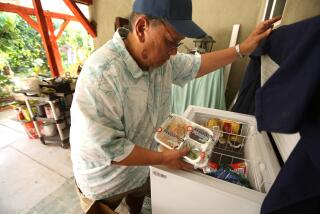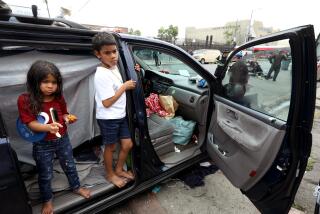Our Saviour Center Gives Needy Food --and a Lot More
- Share via
EL MONTE — It started out as a free food bank, but today it looks more like an elaborate church bazaar.
On a typical day at the Our Saviour Center, a line of people stretches out the door of the former rectory on Santa Anita Avenue. They’re waiting for the free food.
But there also are people waiting to see a doctor, who pokes and prods patients in a back room. In the yard, people pick through racks of secondhand clothing. A group of women learn housecleaning skills in the Sunday school hall. And, in an air-conditioned trailer in the parking lot, preschool children take their first, halting lessons at computers.
Call it an organic approach to the problems of the poor, said center director Dorris Dann. The center offers a variety of services to the poor in the El Monte area.
“You start out giving people food, then things happen,” she said. “You find out right away that there are people who need jobs. . . .”
The center--sponsored by the Our Saviour Episcopal Church in San Gabriel but housed in the facilities of the Immanuel Epsicopal Church in El Monte--has been unobtrusively helping poor families for five years.
Last year it handed out 425 tons of food, gave free medical care to 951 families and helped hundreds of homeless people to find shelter on cold nights.
Headquarters for the program, which has a paid staff of seven and numerous volunteers, is a tan stucco building behind the main Immanuel Church on Santa Anita Avenue.
A chalkboard in the “living room” lists the food items available. On this day, there are butter, flour, cornmeal, honey, peanut butter and grapefruit juice.
But those are just the federal surplus items, said Dann, a retired buyer for The Broadway. The program, with an annual budget of about $300,000, chips in food from the Los Angeles Regional Food Bank and items that are bought with Our Saviour’s own money. Each family usually gets two large bags of groceries twice a month.
In the food bank storage area in back of the house, there are boxes of potatoes and grapefruit, as well as cartons of cereal and rice, waiting to be distributed.
“We try to take care of people’s immediate needs,” said Dann, who took the job as “sort of a little something to do” but found herself working at “the most full-time job I’ve ever had.”
The immediate needs can be monumental.
Among those waiting to see the doctor is Guillermina Garcia, 33, a stocky woman with frizzed blond hair. She and her five children arrived--illegally--from Mexico City only a week ago.
“Work was very scarce in Mexico--barely one day a week,” she said in Spanish. “We took a bus to Tijuana, and one night, we went to the border with a large group of people. We all ran. I told the children, ‘If anybody gets caught, we should all stop.’ But we all made it.”
Since then, the family has joined another family in a house in the area, and Garcia found a job in a factory. Then she slipped on a sidewalk and cracked a vertebra, and her youngest child got sick.
“He hasn’t eaten in four days,” Garcia said, pushing her 8-year-old son forward. “He says his stomach hurts.”
The boy looked up listlessly, his eyelids drooping.
Dr. Thomas Farnham, a general practitioner from the Community Health Foundation of East Los Angeles, which staffs the weekly clinic, said he’s seeing a lot of cases of scabies (a skin disease), some upper respiratory illnesses and some ear infections.
“For most of the people who come here, medical care is a low priority,” he said. “The exigencies of daily life come first. If they have food and shelter and if they have the time, then maybe they’ll think about medical care.”
Thus, the illnesses treated at the little makeshift clinic tend to be relatively advanced.
Garcia’s problems may be typical of those lining up at Our Saviour, but her immigration status is not, Dann said.
“There’s a common misconception that only illegal immigrants cannot find jobs,” Dann said. “But there are many, many legal immigrants, about 90% of the people who come here, who can’t find jobs.”
The job searchers are routed to job developer Marcella Lamar. As with most of the center’s programs, Lamar’s is based on the expressed needs of the clients.
“Most of the people have been spending all day beating the streets, going from door to door,” said Lamar, who, in a year on the job, has picked up a workable knowledge of Spanish. “Sometimes there’s a language barrier. With the 18-year-old, it’s not knowing where to start. We try to give them an idea of what to expect out there.”
For example, Lamar helps would-be job applicants to fill out applications, just the way they would in an employment or personnel office.
“In Mexico, you just go to the boss, and if he wants you, you work,” said Maximino Leon, who is looking for construction work. “It’s pura palabra , just spoken words.”
Lamar explained the subtle mysteries of the application form--such as the question “Is there additional experience which qualifies you for the job?”--and checked her own list of available jobs.
“There is much construction very far-- muy lejos-- from El Monte,” she told Leon. “There is very little in El Monte.”
Twice a week, Lamar conducts classes on housecleaning (“A good housecleaner can earn as much as a factory worker,” she said), teaching women the uses of detergents and floor waxes. “Most of them have been cleaning their own houses for years, but doing it professionally is different,” she said.
For children, there’s Margarita Ponce’s youth program, everything from teaching numbers and colors to preschoolers to leading older children on expeditions to the library. There are also the center’s eight IBM personal computers, with special teaching programs for all ages.
Dann watched a group of 4-year-olds pecking at keyboards. “By the end of the year, they’ll be coming in here, selecting their own disks and writing little stories on their own,” she said.
By early afternoon, cornmeal and grapefruit juice have been erased from the food bank chalkboard, and the last families are collecting their groceries.
Dann sees a kind of historic significance to the center’s work. “El Monte used to be the end of the Santa Fe Trail,” she said. “It’s still like that, with a lot of immigrants reaching the end of the trail here.”
More to Read
Sign up for Essential California
The most important California stories and recommendations in your inbox every morning.
You may occasionally receive promotional content from the Los Angeles Times.













